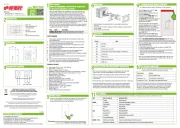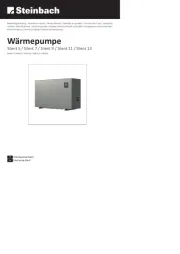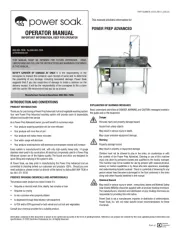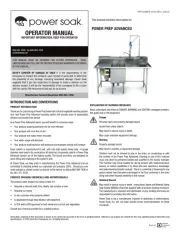Vemer EVR-R Handleiding
Vemer
Niet gecategoriseerd
EVR-R
Bekijk gratis de handleiding van Vemer EVR-R (3 pagina’s), behorend tot de categorie Niet gecategoriseerd. Deze gids werd als nuttig beoordeeld door 102 mensen en kreeg gemiddeld 4.4 sterren uit 51.5 reviews. Heb je een vraag over Vemer EVR-R of wil je andere gebruikers van dit product iets vragen? Stel een vraag
Pagina 1/3

V3IS00282-100
DIMENSIONI
SCHEMI DI COLLEGAMENTO
EVR-R
EVR-R
EVR-D
EVR-D
Manuale d’Uso
VOLTMETRO-AMPEROMETRO DIGITALE CON RELÈ DI MIN/MAX
Leggere attentamente tutte le istruzioni
■ EVR è uno strumento elettronico multifunzione che può essere configurato come voltmetro
o amperometro, dotato di un’uscita relè che viene attivata al superamento di una soglia
impostabile.
Esegue azioni di tipo 1B (60730-1).
AVVERTENZE DI SICUREZZA
Durante l’installazione ed il funzionamento dello strumento è necessario attenersi alle
seguenti prescrizioni:
1) Lo strumento deve essere installato da persona qualificata rispettando scrupolosamente
gli schemi di collegamento
2) Dopo l’installazione deve essere garantita l’inaccessibilità ai morsetti senza l’uso di
appositi utensili
3) Non alimentare o collegare lo strumento se qualche parte di esso risulta danneggiata
4) Nell’impianto elettrico dell’edificio in cui lo strumento va installato deve essere presente
un interruttore e un dispositivo di protezione dalle sovracorrenti
5) Lo strumento è destinato ad essere utilizzato in ambienti con categoria di sovratensione
III e grado di inquinamento 2, secondo norma CEI EN 61010-1.
6) L’apparecchio deve essere installato e messo in funzione in conformità con la normativa
vigente in materia di impianti elettrici.
Codice Modello Descrizione Contenitore
VM331600 EVR-D Voltmetro/Amperometro con relè 115÷230 VAC 4 DIN
VM332400 EVR-R Voltmetro/Amperometro con relè 115÷230 VAC 72x72
VM332402 EVR-R Voltmetro/Amperometro con relè 24 VAC 72x72
CARATTERISTICHE TECNICHE
• Alimentazione:
- 115 ÷ 230 V AC (-15% ÷ +10%) 50/60 Hz (codici VM331600 e VM332400)
- 24 V AC (-15% ÷ +10%) 50/60 Hz (codice VM332402)
• Autoconsumo massimo:
- 6VA (2W) a 230 V AC
- 4VA (2W) a 115 V AC
- 4VA (3W) a 24 V AC
• Misura minima: 3% del fondo scala (sia voltmetro che amperometro)
• Misura massima: 120% del fondo scala (100% per la scala 999)
• Precisione: ± (0.5% del fondo scala ± 1 digit)
• Terminazione per i collegamenti:
- masselli per cavi con sezione massima di 6 mm² per EVR-D
- morsettiera ad innesto per cavi con sezione massima di 2,5 mm² per EVR-R
• Impedenza ingresso voltmetrico: 2 MΩ per 600V di fondo scala
• Caduta di tensione amperometrica: 50 mV per 5A di fondo scala
• Sovraccarico:
- Voltmetrica: 720 V (permanente)
- Amperometrica: 1.2 In (permanente)
• Uscita: relè con contatto in scambio10A / 230VAC su carico resistivo
• Indicazione:
- display a 3 cifre a led per la visualizzazione della grandezza misurata e dei parametri
- led rosso per l’indicazione dello stato del relè
- 3 led rossi (V , A , kA) per l’indicazione dell’unità di misura della grandezza visualizzata
• Temperatura di funzionamento: 0°C ÷ +50°C
• Temperatura di immagazzinamento: -20°C ÷ +70°C
• Umidità relativa: 20% ÷ 90% non condensante
• Isolamento: circuiti di alimentazione, di misura e uscita relè isolati galvanicamente a livello
di isolamento principale (CEI-EN 61010-1). Parti accessibili e altri morsetti isolati a livello
di isolamento rinforzato.
• Grado di protezione: IP20 / IP51 sul frontale
lNSTALLAZIONE
Per l’installazione e l’avvio dello strumento procedere come segue:
1. Effettuare i collegamenti rispettando gli schemi riportati in
questo manuale
2. Tenere premuto il tasto e alimentare lo strumento
3. Scegliere come utilizzare lo strumento e confermare
premendo il tasto
- U = voltmetro
- A = amperometro
3.1. Qualora lo strumento funzioni da amperometro è
necessario impostare il rapporto di trasformazione.
Scegliere il rapporto di trasformazione desiderato e
confermare premendo il tasto .
I valori selezionabili per il rapporto di trasformazione sono:
- tutti i multipli di 5 nell’intervallo compreso tra 5 e 995
- tutti i multipli di 50 nell’intervallo compreso tra 1000 e 8000
4. Lo strumento visualizza la portata selezionata facendo
lampeggiare per 3 volte il rapporto di trasformazione scelto
(per valori pari o superiori a 1kA lampeggia anche il led
kA), dopo di che richiede l’inserimento del vari parametri di
funzionamento
5. Impostare i parametri di funzionamento dello strumento.
5.1. Per passare da un parametro al successivo, premere
il tasto .
La sequenza è: SET, diF, rit, ALL, h-l
5.2. Per modificare il parametro selezionato, premere il
tasto , modificare il valore con i tasti e e
confermare premendo nuovamente il tasto
6. Una volta impostati tutti i parametri, selezionare ESc e
confermare premendo il tasto
7. Lo strumento inizia a funzionare visualizzando a display il
valore della grandezza misurata.
L’unità di misura è indicata dal led relativo (V, A o kA)
L’eventuale intervento del relè è segnalato dall’accensione
del led relativo (Out ON).
FUNZIONAMENTO
• Modifica dei parametri di funzionamento
Per entrare nel menù di programmazione e modificare un valore:
1. Premere il tasto . Il display visualizza il primo menù della lista (SEt)
2. Con i tasti e si scorrono in sequenza le varie voci della lista (set, dif, rit, all, h-l,
esc)
3. Per modificare il parametro visualizzato:
1. premere il tasto . Lampeggia il valore attualmente impostato
2. usare i tasti e per cambiare il valore
3. premere nuovamente il tasto per confermare il valore e tornare alla lista dei menù
4. Per uscire dal menù di programmazione, selezionare la voce ESC e premere
Nota: trascorsi 30 secondi dall’ultima pressione di un tasto, si esce automaticamente dal
menù di programmazione, tornando al normale funzionamento.
• Visualizzazione rapida del valore di soglia e della logica di funzionamento
Durante il normale funzionamento dello strumento è possibile visualizzare il valore di
setpoint:
- premendo il tasto se la logica di massima
- premendo il tasto se la logica è di minima
Premendo il tasto quando la logica impostata è quella di minima o il tasto quando
la logica impostata è quella di massima sul display compare il simbolo . In questo ___
modo è possibile dedurre con che logica sta funzionando il prodotto
• Messaggio di errore ( )EEE
Indica che si è verificato un errore di lettura dati durante lo startup dello strumento. In
questo caso ripetere la procedura di accensione.
Se il problema persiste, contattare l’assistenza tecnica Vemer SpA
• Messaggi di overflow ( e )XXX 000
Se il valore del segnale misurato supera il valore massimo, lo strumento visualizza .XXX
Se il valore del segnale misurato è inferiore al valore minimo, lo strumento visualizza .000
Mod. EVR-R
EVR-D
45
65
5
75
14
66
70
87
EVR-D
72
1 2 987654
1413121110
3
18171615
~
600V~
V
A
x/5 A ~
Alimentazione
7 123456
~
600V~
V
A
x/5 A ~
8
Alimentazione
PARAMETRI DI FUNZIONAMENTO
Di seguito la descrizione dei parametri di funzionamento dello strumento.
• SEt rappresenta il valore della soglia di intervento
• DIF rappresenta il differenziale, ovvero la minima variazione della grandezza
misurata affinchè si esca dalla condizione di allarme
• rit esprime il ritardo di attuazione, ovvero dopo quanti secondi di superamento della
soglia di intervento scatta l’allarme
• ALL per impostare la modalità di allarme (temporanea o permanente).
Se All = on lo strumento attiva il relè al superamento della soglia e rimane attivo
anche se la condizione che p1-ha generato l’allarme cessa. In questo caso lo stato di
allarme può essere sbloccato soltanto manualmente, accedendo a questo menù è
impostando a offALL
• H-L per impostare la logica di funzionamento (H = logica di massima, L logica di
minima)
• per uscire dal menù di programmazioneESC
Esempi di configurazione:
dif
SEt
Relè di massima, all=off
dif
SEt
Relè ON
Relè OFF
rit rit
Relè di minima, all=off
SEt
Relè ON
Relè OFF
dif
rit rit
Relè di minima, all=on
dif
SEt
Relè ON
Relè OFF
rit ritrit rit
Relè ON
Relè OFF
Relè di massima, all=on
NORME DI RIFERIMENTO
La conformità alle direttive Comunitarie:
2006/95/CE (bassa tensione)
2004/108/CE (compatibilità elettromagnetica)
è dichiarata in riferimento alle seguenti norme armonizzate:
• CEI EN 61010-1
• CEI EN 61000-6-2 e CEI EN 61000-6-4
2 s
2 s

V3IS00282-100
DIMENSIONS
CONNECTION DIAGRAMS
EVR-R
EVR-R
EVR-D
EVR-D
User Manual
DIGITAL VOLTMETER-AMMETER WITH MAX/MIN. RELAY
Read all instructions carefully
■ EVR is a multifunction electronic instrument which can be configured as voltmeter or
ammeter, fitted with an output relay which is activated when a settable threshold is
exceeded.
It performs actions of 1 B type (60730-1).
SAFETY WARNINGS
During the installation and the instrument operation it’s necessary to comply with the
following instructions:
1) The instrument should be installed by a competent operator who should follow the
connection diagrams
2) After the installation, inaccessibility to the connection terminals without appropriate
tools must be guaranteed
3) Do not power on or connect the instrument if any part of it is damaged
4) In the electrical system of the building where the instrument must be installed the
presence of a switch and a protection device from overcurrents is necessary
5) The instrument is aimed to be used in environments with category of III overvoltage and
degree of pollution 2, according to the standard CEI EN 61010-1 .
6) The instrument must be installed and activated in compliance with current electric
systems standards.
Code Model Description Container
VM331600 EVR-D Voltmeter/Ammeter with relay 115÷230 VAC 4 DIN
VM332400 EVR-R Voltmeter/Ammeter with relay 115÷230 VAC 72x72
VM332402 EVR-R Voltmeter/Ammeter with relay 24 VAC 72x72
TECHNICAL CHARACTERISTICS
• Power supply:
- 115 ÷ 230 V AC (-15% ÷ +10%) 50/60 Hz (codes VM331600 and VM332400)
- 24 V AC (-15% ÷ +10%) 50/60 Hz (code VM332402)
• Maximum consumption:
- 6VA (2W) at 230 V AC
- 4VA (2W) at 115 V AC
- 4VA (3W) at 24 V AC
• Minimum measurement: 3% of scale (both voltmeter and ammeter)
• Maximum measurement: 120% of scale (100% for 999 scale)
• Precision: ± (0.5% of scale ± 1 digit)
• Terminals for connections:
- blocks for cables with maximum section of 6 mm² for EVR-D
- clip-on terminal board for cables with maximum section of 2,5 mm² for EVR-R
• Voltmeter input impedance: 2 MΩ for 600V of scale
• Ammeter voltage drop: 50 mV for 5A of scale
• Overload:
- Volt: 720 V (permanent)
- Amm: 1.2 In (permanent)
• Output: relay with 10A / 230VAC exchange contact on resistant load
• Indication:
- 3 led digits display for the visualization of the gauged measurement and of parameters
- red led for the indication of the relay status
- 3 red leds (V , A , kA) for the indication of the measurement unit
• Operating temperature: 0°C ÷ +50°C
• Storage temperature: -20°C ÷ +70°C
• Relative humidity: 20% ÷ 90% non-condensing
• Insulation: power supply, measurement and output circuits galvanically insulated at
main insulation level (EN 61010-1). Accessible parts (frontal) and all the other terminals
insulated with reinforced insulation
• Degree of Protection: IP20 / IP51 on the Front Panel
INSTALLATION
For the installation and the start-up of the instrument respect the following instructions:
1. Make the connections in compliance with the diagrams
represented in this manual
2. Press the key and power the instrument
3. Choose how to use the instrument and confirm by pressing
the key
- U = voltmeter
- A = ammeter
3.1. If you have decided to use the instrument as
ammeter it’s necessary to set the transformation
ratio.
Choose the desired transformation ratio and confirm
by pressing the key .
The selectable values for the transformation ratio are the following:
- all multiple of 5 between 5 and 995
- all multiples of 50 between 1000 and 8000
4. The instrument shows the selected capacity by making
flash 3 times the selected transformation ratio (for values
equivalent or higher than 1 kA also Ka led flashes) after
which it requires the insertion of the different operating
parameters
5. Set the operating parameters of the instrument.
5.1. To move from a parameter to the next one, press the
key il tasto .
The sequence is the following: SET, diF, rit, ALL, h-l
5.2. To modify the selected parameter, press the key
, modify the value with the keys and and
confirm by pressing again the key
6. Once all the parameters are set, select and confirm by ESc
pressing the key
7. The instrument begins to operate by showing the value of
the gauged measurement on the display.
The measurement unit is indicated by the corresponding
led (V, A o kA)
The eventual relay intervention is signalled with the switch
on of the corresponding led (Out ON).
OPERATION
• Modified operating parameters
To enter the programming menu and to modify a value:
1. Press the key . The display shows the current set value (SEt)
2. With the keys and the various items of the list will run in sequence (set, dif, rit,
all, h-l, esc)
3. To modify the displayed parameter:
1. press the key . The current set value flashes
2. press the keys and to change the value
3. press again the key to confirm the value and to return to the menu list
4. To exit the programming menu, select the item ESC and press
Note: 30 seconds after a key was last pressed, the instrument automatically leaves the
programming menu and normal operation is resumed.
• Quick displaying of threshold value
During normal instrument operation it’s possible to display the setpoint value:
- by pressing the key if the logic is maximum
- by pressing the key if the logic is minimum
By pressing the key when the set logic is the minimum one or the key when the
set logic is the maximum one the display shows the symbol . In this way it’s possible ___
to understand which is the logic with whom the product is operating
• Error message ( )EEE
It indicates that an error of data reading is occured during the instrument startup. In this
case repeat the switch on procedure.
If the problem persists, contact Vemer Spa Technical Service.
• Overflow messages ( e )XXX 000
If the value of the measured signal is higher than the maximum value, the instrument
shows .XXX
If the value of the measured signal is lower than the minimum value, the instrument
shows .000
Mod. EVR-R
EVR-D
45
65
5
75
14
66
70
87
EVR-D
72
1 2 987654
1413121110
3
18171615
~
600V~
V
A
x/5 A ~
Power supply
7 123456
~
600V~
V
A
x/5 A ~
8
Power supply
OPERATING PARAMETERS
Below, the description of the operating parameters of the instrument.
• SEt represents the value of activation threshold
• DIF represents the hysteresis, that is to say the minimum variation of the gauged
measurement to exit the alarm status
• rit indicates the actuation delay, that is to say after how many seconds of
intervention threshold overcoming the alarm starts
• ALL to set the alarm mode (temporary or permanent).
If ALL = on the instrument activates the relay when the threshold is overcome and
it stays on even if the status which generated the alarm ends. In this case the alarm
status can be unlocked only manually, by entering this menu and by setting ALL
• H-L to set the operating logic (H = maximum logic, L minimum logic)
• ESC to exit the programming menu
Exemples of parameters setting
dif
SEt
Maximum relay mode, all=off
dif
SEt
Relay ON
Relay OFF
rit rit
Minimum relay mode, all=off
SEt
Relay ON
Relay OFF
dif
rit rit
Minimum relay mode, all=on
dif
SEt
Relay ON
Relay OFF
rit ritrit rit
Relay ON
Relay OFF
Maximum relay mode, all=on
REFERENCE STANDARDS
Conformity with the community directives:
2006/95/CE (low voltage)
2004/108/CE (electromagnetic compatibility)
is declared with reference to the following harmonised standards:
• EN 61010-1
• EN 61000-6-2 and EN 61000-6-4
2 s
2 s
Product specificaties
| Merk: | Vemer |
| Categorie: | Niet gecategoriseerd |
| Model: | EVR-R |
Heb je hulp nodig?
Als je hulp nodig hebt met Vemer EVR-R stel dan hieronder een vraag en andere gebruikers zullen je antwoorden
Handleiding Niet gecategoriseerd Vemer

17 Juni 2025

5 September 2023

17 Juni 2023

17 Juni 2023

12 Juni 2023

5 Juni 2023

2 Juni 2023

31 Mei 2023

29 Mei 2023

24 Mei 2023
Handleiding Niet gecategoriseerd
- Homelite
- Astralpool
- EMotimo
- Nanni
- SmallRig
- Humax
- Naxa
- Cellular Line
- Tunturi
- NordicTrack
- Hecate
- VCDS
- Garden Feelings
- Beemoo
- Narwal
Nieuwste handleidingen voor Niet gecategoriseerd

15 September 2025

15 September 2025

15 September 2025

15 September 2025

15 September 2025

15 September 2025

15 September 2025

15 September 2025

15 September 2025

15 September 2025